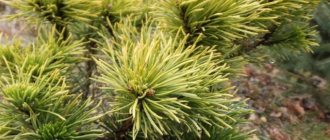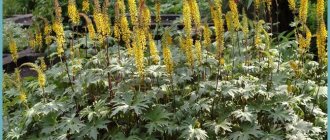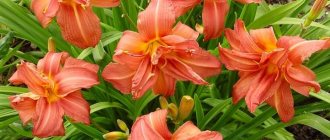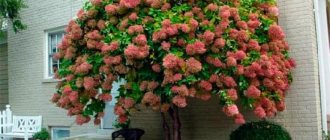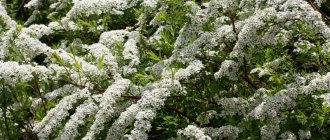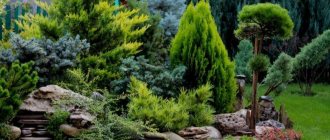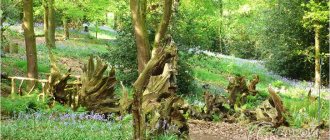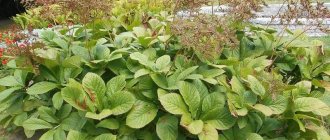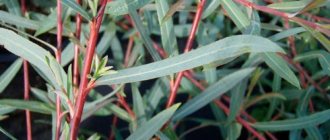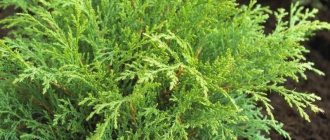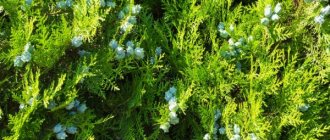When thinking about designing their own garden, many people dream of contemplating all season long something charming, beautiful enough to decorate the front area and at the same time, not requiring constant attention. Paniculate and tree-like hydrangeas meet all these requirements and are ideal for growing in areas near Moscow.
Dozens of different varieties allow you to play with heights and shades. Thanks to such diversity and conditions favorable for growth, this shrub is called universal. In this article we will look at just a few fundamentally different options for using hydrangea in garden landscape design and learn about all its advantages.
Hydrangea with perennials
For example, imagine a situation where buildings, a fence or other structures form a corner on a site that receives no more than 4 hours of sunlight during the day. Someone was already desperate to improve this place and equipped it for storing tools, a garden cart, and maybe even gave it over to weeds. Hydrangea will cope with this task without effort. The picture below shows a specific example of such a mixborder.
Surrounded by interesting landscape stones and shade-tolerant perennials, this shrub looks attractive, maintaining its beauty until frost. Please note: the composition is located right next to the house, but the plants are chosen so advantageously that they are not afraid of snow falling from the roof. In winter, perennials lack an above-ground part, and in hydrangeas, even if the branches break off, in the spring the buds below the break will wake up, developing shoots that will be crowned with inflorescences in July.
Hydrangea: description and characteristics of the plant
The hit of modern garden design is hydrangea. The botanical description indicates the corymbose, paniculate and spherical shape of the inflorescences. The flower "garden hydrangea" or "Hydrangea" has dense petals that do not get wet from dew or precipitation. Buds appear on shoots in spring and bloom until early autumn. The buds droop only after sustained frosts. Even the first snow is not scary for flowers.
When you see these lush buds, you get a feeling of lightness and airiness. I would like to plant whole rows of hydrangeas so that their caps attract attention and decorate the garden plot
Most varieties have a base color of white, less often cream or pale pink. But in flower beds, colorful hats surprise with their diversity. The color of the inflorescences depends not only on the variety of hydrangeas. Pigmentation is affected by acidity. The shrub prefers slightly acidic soil. The more acidic the earth, the more shades of blue there are in the palette. This is due to an increase in aluminum concentration. The oxide solution is quickly absorbed by the roots of the flowers.
The color of garden hydrangea flowers depends greatly on the acidity of the soil.
Gardeners determine the pH level by the color of hydrangeas:
- with increasing alkaline ions, a lilac tint appears or the bushes become noticeably pink;
- in a neutral environment, the color of the petals is beige, cream, milky or snow-white;
- When the acidity increases, the flowers turn blue or turn blue.
The plant is moisture-loving and requires regular watering. In areas with stagnant water, the root system is inhibited and drainage is necessary. Hydrangea is sun-loving, but at noon a little shading is desirable, otherwise the color of the flowers will suffer. Excess fertilizer affects the quality of flowering; minerals must be added according to the instructions. With intensive nitrogen fertilizing, the number of inflorescences is sharply reduced.
A place for hydrangea must be chosen in advance and the soil must be prepared in advance.
The care rules recommend winter shelters. Young bushes are covered especially carefully before the shoots become woody. Plants reproduce vegetatively and by dividing the bush during transplantation.
Mixborder with hydrangea in the shade
Sometimes the shadow is formed by the crown of tall trees growing on your or a neighboring site. As a rule, this is not such an inconspicuous corner, which means it is simply necessary to improve it. We offer you an all-round view composition option that will look charming from any point. And the spotlight is again on two charming hydrangea bushes.
It is worth noting that there were also landscape stones here. Thanks to them, the composition has a natural style and does not seem “naked” in the spring, while the plants have not yet woken up. For this mixborder, not only classic shrub forms, but also standard forms of hydrangeas can be suitable.
If you really decide to improve a shady corner on your site, we recommend that you read the article “Unpretentious shade-loving plants for your garden”, where there are many species and varieties of shrubs and perennials that will be comfortable in partial shade.
Flowerbed for beginners
To create a simple flower bed, it is advisable to use flowers that do not require special care and growing conditions, but you can be sure of their long-lasting attractive appearance and flowering time. As a basis for a simple flower bed, you can take a diagram: in the center there is a hydrangea, then bulbs (daffodils and tulips), astilbe, fern, chrysanthemum, violet, lily of the valley, marigolds, and carnations are planted in a circle.
Children's flowerbed
Creating a children's flowerbed is a great way to captivate a child, teach him to work, respect for nature, and responsibility. To make the activity fun, you can plant colorful flowering bushes.
At the same time, when decorating a flowerbed for a boy, flowers in blue colors are used (crocuses, violets, muscari, delphiniums, scillas, forget-me-nots, cornflowers, nigella, asters). The highlights of the composition can be blue or purple hydrangea, as well as blue spruce.
For girls, delicate flowers of red-pink color are selected (hyacinths, tulips, peonies, lilies, daisies, pansies, petunias). Viburnum or rhododendron can complement the flowerbed.
Shady flower bed with daylilies
If you need to decorate a corner where there is almost no sun, you can try the following flower bed option. In the center are hydrangeas of the Kyushu variety and daylilies (common red or Stela de Oro). Next - late-flowering narcissus, hosta zibolida, wood violet, ivy and columbine. This composition always looks fresh and original and requires virtually no maintenance.
Hydrangea with daylilies
Flowerbed along a fence or wall
A riot of hydrangea along the wall of a house or fence is a stunning and unique sight. This result is difficult to achieve, but it is impressive. When planting hydrangeas, you should immediately determine which plant will be the tallest. If it is a hydrangea, then a tree-like species is selected and planted in the background. At the front, the flower garden is complemented by small flowers and herbaceous plants.
If a conifer or other tree is chosen as the largest crop, it is placed at the back. Hydrangea should be selected paniculate and planted in the first row.
Hydrangea by the fence
Hydrangea is a beautiful and spectacular plant that is easy to care for and is in demand in landscape design. It goes well with many flowers, trees, and herbaceous areas, thanks to which you can create original and unique compositions. Hydrangea will be a worthy decoration for any garden or flower bed.
Parterre flower garden with hydrangea
Rows of low-growing hydrangeas can decorate a parterre flower garden. Perennials will highlight the attractiveness of these flowering shrubs and create a contrasting background for bright and large rose buds. Over the years, hydrangeas will grow and form an interesting border with lush greenery in the first half of summer and lush white inflorescences at the end of July, which will begin to turn pink closer to autumn.
Using these three options as an example, we found out that hydrangea can not only highlight the advantages, but also hide the shortcomings of your site. Knowing about these features of the shrub and taking into account the nuances of the variety, you can use it for almost any purpose.
If we talk about mixborders, then you should choose paniculate hydrangeas, because most tree-like hydrangeas have a certain feature due to which the integrity of the composition may suffer: their inflorescences are incredibly large and under their weight the shoots can bend almost to the ground, increasing the diameter of the bush and making its somewhat sloppy. But many find a solution to this situation too. You can build a retaining structure along the perimeter of the bush and plant plants nearby that will cover it from view. What is tree hydrangea best suited for?
Which plants to choose
Flowering perennials: interesting combinations
What plants will most effectively highlight the beauty of hydrangea and sparkle next to it with new bright colors? Let's figure it out.
Hydrangea and roses in landscape design are one of the very successful combinations, especially if the hydrangea grows on a trunk. It is better to choose varieties of roses that are not too tall, for example, floribundas, and with small-sized flowers - then the contrast between delicate roses and paniculate hydrangeas with large pyramid-shaped inflorescences will be especially pronounced.
But the color of the petals does not matter, since the universal white color of hydrangeas goes well with both bright and delicate colors. However, roses of a light palette - beige, cream, white, light pink - look most elegant next to hydrangeas. Although red roses will create an interesting contrast.
Peonies perfectly highlight the beauty of hydrangeas - perhaps the only disadvantage of such compositions is that peonies fade in early July, when buds are just beginning to appear on the bush. But there are also advantages - at the beginning of summer, when the hydrangea is not yet blooming, but is already covered with pretty leaves, blooming peonies will decorate it perfectly.
Add roses, astilbes, low varietal daylilies and bearded irises to the composition, and your flowerbed will play with colors and a variety of shapes all season long.
Veil plants: the charm of grace
If you want to achieve grace and sophistication that will never be out of place, add veil plants - for example, gypsophila - to flowering perennials.
They belong to the carnation family and are distinguished by their diversity - in total there are more than a hundred species of these flowers. The colors of the petals come in a variety of colors, but white gypsophila attracts great attention - these are the flowers that are added to bouquets of roses to give them completeness.
Gypsophila is generally recommended to be planted with large bright flowers for contrast and to give the flower garden some airiness, so they will perfectly shade peonies, irises, and daylilies. Moreover, the agricultural technology of all these plants is approximately the same - they love the sun, do not tolerate excess moisture near the roots and do not favor drafts.
In one place, with good care, gypsophila grows up to twenty-five years, becoming more and more beautiful, so the neighborhood can be long. They rarely get sick, especially if you don’t overdo it with watering.
In addition to gypsophila, other veil plants will cope with the task: fragrant bedstraw with its magnificent aroma, delicate mantle, which is considered an excellent neighbor for peonies, openwork Buenos Aires verbena.
A very beautiful plant is perennial flax with its sky-blue flowers, which feels great in any sunny area and blooms until late autumn.
Decorative foliage plants: a beautiful frame
If you are not a fan of too bright compositions and want to focus on the hydrangea, add plants with large leaves that will frame the flowering shrub.
Any coniferous plants, junipers, hostas, heucheras and even ferns are perfect for these purposes.
Hydrangeas and hostas are very common in landscape design. Considering the variety of hostas, which are very different in leaf color and size, only with the help of these plants can you wonderfully design a flower garden. At the same time, you will easily achieve your goal - the hydrangea will remain in the foreground, and the hosts will be its companions.
The same can be said about heucheras, which simply amaze with their colors, about conifers and ferns with carved leaves. The coniferous and hydrangea design is one of the most advantageous.
Herbs and grains: an unusual solution
And for lovers of ornamental grasses - by the way, grasses are now at the peak of popularity, even rose gardens are diluted with them and it looks interesting and original - we can advise planting fescue, falaris, cortaderia or miscanthus next to hydrangeas.
Keep in mind that miscanthus, not often found in our gardens, but an extremely interesting perennial herb, loves moisture, like hydrangea, so you can safely plant them nearby without fear that your companion will suffer from overwatering.
You can fill the voids between large perennials with the help of ground cover plants - unpretentious tenacity, awl-shaped phlox, false sedum, creeping thyme, periwinkle with its discreet blue flowers or even juveniles will make the composition complete, and at the same time will crowd out the weeds that make even the most beautiful flower garden sloppy .
Tree hydrangea hedge
Quite often this species can be found both in a single planting and in a hedge, when the lack of elasticity of the shoots is used as an advantage.
If in the first case the bush seems to be holding up a charming border of thujas of the “Danika” variety, then in the second the shoots gracefully fall onto the surface of the water, being reflected in it and giving depth and scale to the landscape.
Decorating a recreation area with tree hydrangea
This shrub, even without the support of other plants, will decorate any part of your garden in a monochrome, sophisticated style. True, unlike paniculata, tree hydrangea bushes are not so tall, so the background can be a building wall or a fence, if they look attractive, or slender rows of thujas, as an option.
Hydrangea paniculata hedges
They are not rare and look simply gorgeous. Some varieties of this species are capable of reaching a height of three and sometimes four meters, creating stunningly beautiful hedges that cannot be ignored and appreciated by their majesty.
In both cases, the designers played with heights to their advantage. In the first photo we see how lush inflorescence caps barely rise above the terrace fence, creating an elegant snow-white border. And in the second photo, the shrubs are planted on a high retaining wall, which certainly adds scale to the landscape and allows you to plant far from the lowest shrubs in front of this wall, creating a multi-tiered effect.
Types and varieties that can be used in garden design
Fortune's euonymus "Emerald Gold" - application in landscape design
Many varietal hydrangeas have been bred. The most common varieties in Russia:
- paniculata;
- tree-like, also called smooth or wild;
- large-leaved, also known as garden;
- petiolate;
- oakleaf.
There are other subspecies of hydrangea, but they are used less frequently in the landscape design of summer cottages in Russia.
Flower varieties and varieties go well together
Paniculata
The natural habitat of this species is Japan, China, Sakhalin Island. The following varieties are used most often to create a composition with paniculata hydrangea in the garden:
- Pinky Winky;
- Grandiflora;
- Vanilla Fries.
All these varietal varieties have large, fragrant inflorescences and require regular formative pruning.
large-leaved
Many varieties of this variety have unevenly colored inflorescences, combining several shades. The following varieties have gained great popularity:
- Ever Peppermint;
- Red Sensation;
- Endless Summer.
Note! Large-leaved hydrangeas are often grown in tubs or baskets and brought indoors for the winter.
Tree-like
This hydrangea is used in the landscape due to its abundant flowering and excellent winter hardiness. The most popular varieties:
- Annabelle;
- Sterillis;
- Invisible Spirit.
The plant is suitable for cutting, forming dry bouquets in boxes or vases. Fits perfectly into any interior, maintaining its shape for a long time.
Chereshkova
A liana-like variety of crop growing on the Kuril Islands and Sakhalin. The following varieties are planted on personal plots:
- Petiolaris;
- Cordifolia;
- Miranda.
The plant prefers partial shade and moist soils.
Oakleaf
The patterned foliage is shaped like oak, the height of the bushes is 2 meters, flowering begins in June. The following varieties became famous:
- Burgundy;
- Amethyst;
- Harmony.
Optimal cultivation in the south of the country. In the central zone and Moscow region, in the first years of life, the flower requires winter shelter.
